Impact of the Limited Heat Source Capacity on Indoor Temperature and Energy Consumption in Serial nZEB Residential Buildings across the Baltic Region
Abstract
:1. Introduction
2. Methods
2.1. Required Standards
- LBN 003-19—Building climatology;
- LBN 231-15—Heating and ventilation of residential and public buildings;
- LBN 002-19—Thermal engineering of building enclosing structures;
- EN 16798-3:2017—Energy performance of buildings and ventilation for buildings;
- EN ISO 7730:2006-05—Ergonomics of the thermal environment.
2.2. Simulation Model and Building Envelope
2.3. Air Tightness
2.4. Indoor Conditions
2.5. Air Handling Unit
2.6. Simulation Cases
- lightweight constructions;
- heavyweight constructions.
- CAV ventilation according to a given schedule;
- CAV ventilation according to a given schedule and the outdoor air temperature.
3. Results
3.1. Load Duration Curve
3.2. Heating Energy Optimization by Extra Thermal Mass and Standard Ventilation
- As part of the analysis, Liepaja was chosen as the location with the highest design temperature, the lowest heating capacity and energy consumption. The heating capacity was limited to 11 kW.
- Thermal mass in the form of concrete was also added for all envelope structures, except for the floor. The layer was 50 mm from the inside of the wall.
3.3. Heating Energy Optimization by Extra Thermal Mass and Optimized Ventilation
4. Discussion
5. Conclusions
Limitations and Future Work
Author Contributions
Funding
Data Availability Statement
Conflicts of Interest
References
- Moran, P.; Goggins, J.; Hajdukiewicz, M. Super-insulate or use renewable technology? Life cycle cost, energy and global warming potential analysis of nearly zero energy buildings (NZEB) in a temperate oceanic climate. Energy Build. 2017, 139, 590–607. [Google Scholar] [CrossRef] [Green Version]
- Staveckis, A.; Borodinecs, A. Impact of impinging jet ventilation on thermal comfort and indoor air quality in office buildings. Energy Build. 2021, 235, 110738. [Google Scholar] [CrossRef]
- Kim, H.; Junghans, L. Economic feasibility of achieving net-zero emission building (NZEB) by applying solar and geothermal energy sources to heat pump systems: A case in the United States residential sector. J. Clean. Prod. 2023, 416, 137822. [Google Scholar] [CrossRef]
- European Commission—A Roadmap for Moving to a Competitive Low Carbon Economy in 2050. 2011. Available online: https://eur-lex.europa.eu/legal-content/EN/TXT/HTML/?uri=CELEX:52011DC0112&qid=1690657323261 (accessed on 12 July 2023).
- Magrini, A.; Marenco, L.; Bodrato, A. Energy smart management and performance monitoring of a NZEB: Analysis of an application. Energy Rep. 2022, 8, 8896–8906. [Google Scholar] [CrossRef]
- Delač, B.; Pavković, B.; Lenić, K.; Mađerić, D. Integrated optimization of the building envelope and the HVAC system in nZEB refurbishment. Appl. Therm. Eng. 2022, 211, 118442. [Google Scholar] [CrossRef]
- D’Agostino, D.; Tzeiranaki, S.T.; Zangheri, P.; Bertoldi, P. Assessing Nearly Zero Energy Buildings (NZEBs) development in Europe. Energy Strat. Rev. 2021, 36, 100680. [Google Scholar] [CrossRef]
- Attia, S.; Kurnitski, J.; Kosiński, P.; Borodiņecs, A.; Belafi, Z.D.; István, K.; Krstić, H.; Moldovan, M.; Visa, I.; Mihailov, N.; et al. Overview and future challenges of nearly zero-energy building (nZEB) design in Eastern Europe. Energy Build. 2022, 267, 112165. [Google Scholar] [CrossRef]
- Guillén-Lambea, S.; Rodríguez-Soria, B.; Marín, J.M. Comfort settings and energy demand for residential nZEB in warm climates. Appl. Energy 2017, 202, 471–486. [Google Scholar] [CrossRef]
- Yılmaz, B.; Yılmaz, Y. Re-considering the energy efficient retrofitting approach to question cost-optimality and nZEB under COVID-19 measures. Build. Environ. 2022, 219, 109227. [Google Scholar] [CrossRef]
- D’Agostino, D.; Zangheri, P.; Castellazzi, L. Towards Nearly Zero Energy Buildings in Europe: A Focus on Retrofit in Non-Residential Buildings. Energies 2017, 10, 117. [Google Scholar] [CrossRef]
- Zuhaib, S.; Goggins, J. Assessing evidence-based single-step and staged deep retrofit towards nearly zero-energy buildings (nZEB) using multi-objective optimisation. Energy Effic. 2019, 12, 1891–1920. [Google Scholar] [CrossRef]
- IEA. Transition to Sustainable Buildings: Strategies and Opportunities to 2050; International Energy Agency: Paris, France, 2013; ISBN 9789264202955. [Google Scholar] [CrossRef]
- Ballarini, I.; De Luca, G.; Paragamyan, A.; Pellegrino, A.; Corrado, V. Transformation of an Office Building into a Nearly Zero Energy Building (nZEB): Implications for Thermal and Visual Comfort and Energy Performance. Energies 2019, 12, 895. [Google Scholar] [CrossRef] [Green Version]
- Borowski, M. Hotel Adapted to the Requirements of an nZEB Building—Thermal Energy Performance and Assessment of Energy Retrofit Plan. Energies 2022, 15, 6332. [Google Scholar] [CrossRef]
- Ye, M.; Nagano, K.; Serageldin, A.A.; Sato, H. Field studies on the energy consumption and thermal comfort of a nZEB using radiant ceiling panel and open-loop groundwater heat pump system in a cold region. J. Build. Eng. 2022, 67, 105999. [Google Scholar] [CrossRef]
- Garkāje, L. Soviet Serial Apartment Buildings in Riga Historical Centre Streetscape. 1945–1990. Arch. Urban Plan. 2020, 15, 122–130. [Google Scholar] [CrossRef]
- Prozuments, A.; Staveckis, A.; Zemitis, J.; Bajare, D. Evaluation of Heating and Cooling Loads for a Well-Insulated Single-Family House under Variable Climate Pattern. Environ. Clim. Technol. 2021, 25, 750–763. [Google Scholar] [CrossRef]
- Paoletti, G.; Pascuas, R.P.; Pernetti, R.; Lollini, R. Nearly Zero Energy Buildings: An Overview of the Main Construction Features across Europe. Buildings 2017, 7, 43. [Google Scholar] [CrossRef]
- Salem, R.; Bahadori-Jahromi, A.; Mylona, A.; Godfrey, P.; Cook, D. Investigating the potential impact of energy-efficient measures for retrofitting existing UK hotels to reach the nearly zero energy building (nZEB) standard. Energy Effic. 2019, 12, 1577–1594. [Google Scholar] [CrossRef]
- Zangheri, P.; Armani, R.; Pietrobon, M.; Pagliano, L. Identification of cost-optimal and NZEB refurbishment levels for representative climates and building typologies across Europe. Energy Effic. 2017, 11, 337–369. [Google Scholar] [CrossRef] [Green Version]
- Bonin, J. Wärmepumpen: Fehler Vermeiden Bei Planung, Installation Und Betrieb; 2., überarbeitete Auflage; Beuth: Berlin, Germany, 2018; 156p, ISBN 978-3-410-28561-8. [Google Scholar]
- Garde, F.; Aelenei, D.; Aelenei, L.; Scognamiglio, A.; Ayoub, J. Solution Sets for Net Zero Energy Buildings: Feedback from 30 Buildings Worldwide; John Wiley & Sons, Inc.: New York, NY, USA, 2017; ISBN 978-3-433-03072-1. [Google Scholar] [CrossRef]
- Halilovic, S.; Odersky, L.; Hamacher, T. Integration of groundwater heat pumps into energy system optimization models. Energy 2022, 238, 121607. [Google Scholar] [CrossRef]
- Ryńska, E.; Koźmińska, U.; Rucińska, J. Effectivity–ecosphere–economics in nZEB retrofit procedures. Environ. Sci. Pollut. Res. 2018, 26, 29544–29559. [Google Scholar] [CrossRef] [Green Version]
- D’Agostino, D. Assessment of the progress towards the establishment of definitions of Nearly Zero Energy Buildings (nZEBs) in European Member States. J. Build. Eng. 2015, 1, 20–32. [Google Scholar] [CrossRef]
- Allard, F.; Braham, D.; van Dijk, D.; Feldmann, C.; Fox, J.; Gräslund, J.; Heiselberg, P.; Hovorka, F.; Kosonen, R.; Lebrun, J.; et al. REHVA nZEB Technical Definition and System Boundaries for Nearly Zero Energy Buildings. Rehva Report No.04; Forssa Print: Forssa, Finland, 2013; ISBN 9782930521091. [Google Scholar]
- Pikas, E.; Thalfeldt, M.; Kurnitski, J. Cost optimal and nearly zero energy building solutions for office buildings. Energy Build. 2014, 74, 30–42. [Google Scholar] [CrossRef]
- D’Agostino, D.; Zangheri, P.; Cuniberti, B.; Paci, D.; Bertoldi, P. Synthesis Report on the National Plans for Nearly Zero Energy Buildings (NZEBs); Publications Office of the European Union: Luxembourg, 2016; ISSN 1831-9424. [Google Scholar] [CrossRef]
- Harkouss, F.; Fardoun, F.; Biwole, P.H. Optimization approaches and climates investigations in NZEB—A review. Build. Simul. 2018, 11, 923–952. [Google Scholar] [CrossRef]
- Horn, V.V.; Dudás, A.; Terjék, A. The Role of Façades in Solar Energy Utilization. Buildings 2020, 10, 209. [Google Scholar] [CrossRef]
- Gaitan, N.C.; Ungurean, I.; Roman, C.; Francu, C. An Optimizing Heat Consumption System Based on BMS. Appl. Sci. 2022, 12, 3271. [Google Scholar] [CrossRef]
- Bux, K. Klima am Arbeitsplatz. Stand Arbeitswissenschaftlicher Erkenntnisse—Bedarfsanalyse Für Weitere Forschungen; Bundesanstalt für Arbeitsschutz und Arbeitsmedizin: Dortmund, Germany, 2006; 33p. [Google Scholar]
- Fanger, P.O. Mensch und Raumklima. In Raumklimatechnik; Rietschel, H., Esdorn, H., Eds.; Band 1. Grundlagen. 16. Auflage; Springer: Berlin/Heidelberg, Germany, 1994; pp. 125–153. ISBN 978-3-540-68938-6. [Google Scholar]
- LBN 003-19; Building Climatology. Cabinet of Ministers: Riga, Latvia, 2019. Available online: https://likumi.lv/ta/id/309453-noteikumi-par-latvijas-buvnormativu-lbn-003-19-buvklimatologija (accessed on 7 July 2023).
- LBN 231-15; Heating and Ventilation of Residential and Public Buildings. Cabinet of Ministers: Riga, Latvia, 2015. Available online: https://likumi.lv/ta/id/274815-noteikumi-par-latvijas-buvnormativu-lbn-231-15-dzivojamo-un-publisko-eku-apkure-un-ventilacija- (accessed on 7 July 2023).
- LBN 002-19; Thermal Engineering of Building Enclosing Structures. Cabinet of Ministers: Riga, Latvia, 2019. Available online: https://likumi.lv/ta/id/307966-noteikumi-par-latvijas-buvnormativu-lbn-002-19-eku-norobezojoso-konstrukciju-siltumte (accessed on 7 July 2023).
- EN 16798-3:2017; Energy Performance of Buildings and Ventilation for Buildings. Beuth Publishing: Berlin, Germany, 2017. Available online: https://www.beuth.de/de/norm/din-en-16798-3/265595146 (accessed on 9 July 2023).
- LVS EN ISO 7730:2006; Ergonomics of the Thermal Environment—Analytical Determination and Interpretation of Thermal Comfort Using Calculation of the PMV and PPD Indices and Local Thermal Comfort Criteria. LVS Standartizācijas Nodaļa, Latvijas Standards: Riga, Latvia, 2006. Available online: https://www.lvs.lv/lv/products/19256 (accessed on 8 July 2023).
- Jung, N.; Paiho, S.; Shemeikka, J.; Lahdelma, R.; Airaksinen, M. Energy performance analysis of an office building in three climate zones. Energy Build. 2018, 158, 1023–1035. [Google Scholar] [CrossRef]
- Brækken, A.; Sannan, S.; Jerca, I.O.; Bădulescu, L.A. Assessment of heating and cooling demands of a glass greenhouse in Bucharest, Romania. Therm. Sci. Eng. Prog. 2023, 41, 101830. [Google Scholar] [CrossRef]
- Recknagel, H.; Sprenger, E.; Albers, K.J. Taschenbuch für Heizung + Klimatechnik 2020/2021, 80th ed.; ITM InnoTech Medien GmbH: Kleinaitingen, Germany, 2020; 2754p, ISBN 978-3-96143-090-1. [Google Scholar]
- Sartori, I.; Napolitano, A.; Marszal, A.; Pless, S.; Torcellini, P.; Voss, K. Criteria for Definition of Net Zero Energy Buildings. In Proceedings of the EuroSun: International Conference on Solar Heating, Cooling and Buildings, Graz, Austria, 28 September–1 October 2010. [Google Scholar] [CrossRef] [Green Version]
- Toleikyte, A.; Kranzl, L.; Bointner, R. Zebra 2020—Nearly Zero-Energy Building Strategy 2020. Strategies for a Nearly Zero-Energy Building Market Transition in the European Union. 2016. Available online: http://bpie.eu/wp-content/uploads/2016/12/ZEBRA2020_Strategies-for-nZEB_07_LQ-double-pages.pdf (accessed on 13 July 2023).
- Voss, K.; Musall, E.; Lichtmeß, M. From Low-Energy to Net Zero-Energy Buildings: Status and Perspectives. J. Green Build. 2011, 6, 46–57. [Google Scholar] [CrossRef]
- Williams, J.; Mitchell, R.; Raicic, V.; Vellei, M.; Mustard, G.; Wismayer, A.; Yin, X.; Davey, S.; Shakil, M.; Yang, Y.; et al. Less is more: A review of low energy standards and the urgent need for an international universal zero energy standard. J. Build. Eng. 2016, 6, 65–74. [Google Scholar] [CrossRef] [Green Version]
- Borodinecs, A.; Bogdanovics, R.; Prozuments, A.; Tihana, J.; Gaujena, B. Evaluation of hybrid heating systems with a combination of fossil and renewable energy sources. In Proceedings of the IOP Conference Series: Earth and Environmental Science, SBE 19—Emerging Concepts for Sustainable Built Environment, Helsinki, Finland, 22–24 May 2019; Volume 297, p. 012050. [Google Scholar] [CrossRef]
- EN 12831-1:2017-09; Energy Performance of Buildings—Method for Calculation of the Design Heat Load—Part 1: Space Heating Load. Beuth Publishing: Berlin, Germany, 2017. Available online: https://www.beuth.de/de/norm/din-en-12831-1/261292587 (accessed on 10 July 2023).
- EN ISO 13370:2018-03; Thermal Performance of Buildings—Heat Transfer via the Ground. Beuth Publishing: Berlin, Germany, 2018. Available online: https://www.beuth.de/de/norm/din-en-iso-13370/259116218 (accessed on 10 July 2023).
- Arcuri, N.; Carpino, C.; De Simone, M. The Role of the Thermal Mass in nZEB with different Energy Systems. Energy Procedia 2016, 101, 121–128. [Google Scholar] [CrossRef]
- Jaysawal, R.K.; Chakraborty, S.; Elangovan, D.; Padmanaban, S. Concept of net zero energy buildings (NZEB)—A literature review. Clean. Eng. Technol. 2022, 11, 100582. [Google Scholar] [CrossRef]
- Romero, M.; Aguilar, F.; Vicente, P. Analysis of design improvements for thermal bridges formed by double-brick façades and intermediate slabs for nZEB residential buildings in Spain. J. Build. Eng. 2021, 44, 103270. [Google Scholar] [CrossRef]
- Kempton, L.; Kokogiannakis, G.; Green, A.; Cooper, P. Evaluation of thermal bridging mitigation techniques and impact of calculation methods for lightweight steel frame external wall systems. J. Build. Eng. 2021, 43, 102893. [Google Scholar] [CrossRef]
- Zhao, K.; Jiang, Z.; Huang, Y.; Sun, Z.; Wang, L.; Gao, W.; Ge, J. The method of reducing heat loss from thermal bridges in residential buildings with internal insulation in the hot summer and cold winter zone of China. J. Build. Eng. 2022, 62, 105421. [Google Scholar] [CrossRef]
- Ahmed, K.; Hasu, T.; Kurnitski, J. Actual energy performance and indoor climate in Finnish NZEB daycare and school buildings. J. Build. Eng. 2022, 56, 104759. [Google Scholar] [CrossRef]
- Sayadi, S.; Akander, J.; Hayati, A.; Cehlin, M. Analyzing the climate-driven energy demand and carbon emission for a prototype residential nZEB in central Sweden. Energy Build. 2022, 261, 111960. [Google Scholar] [CrossRef]
- Chenari, B.; Dias Carrilho, J.; Gameiro da Silva, M. Towards sustainable, energy-efficient and healthy ventilation strategies in buildings: A review. Renew. Sustain. Energy Rev. 2016, 59, 1426–1447. [Google Scholar] [CrossRef]
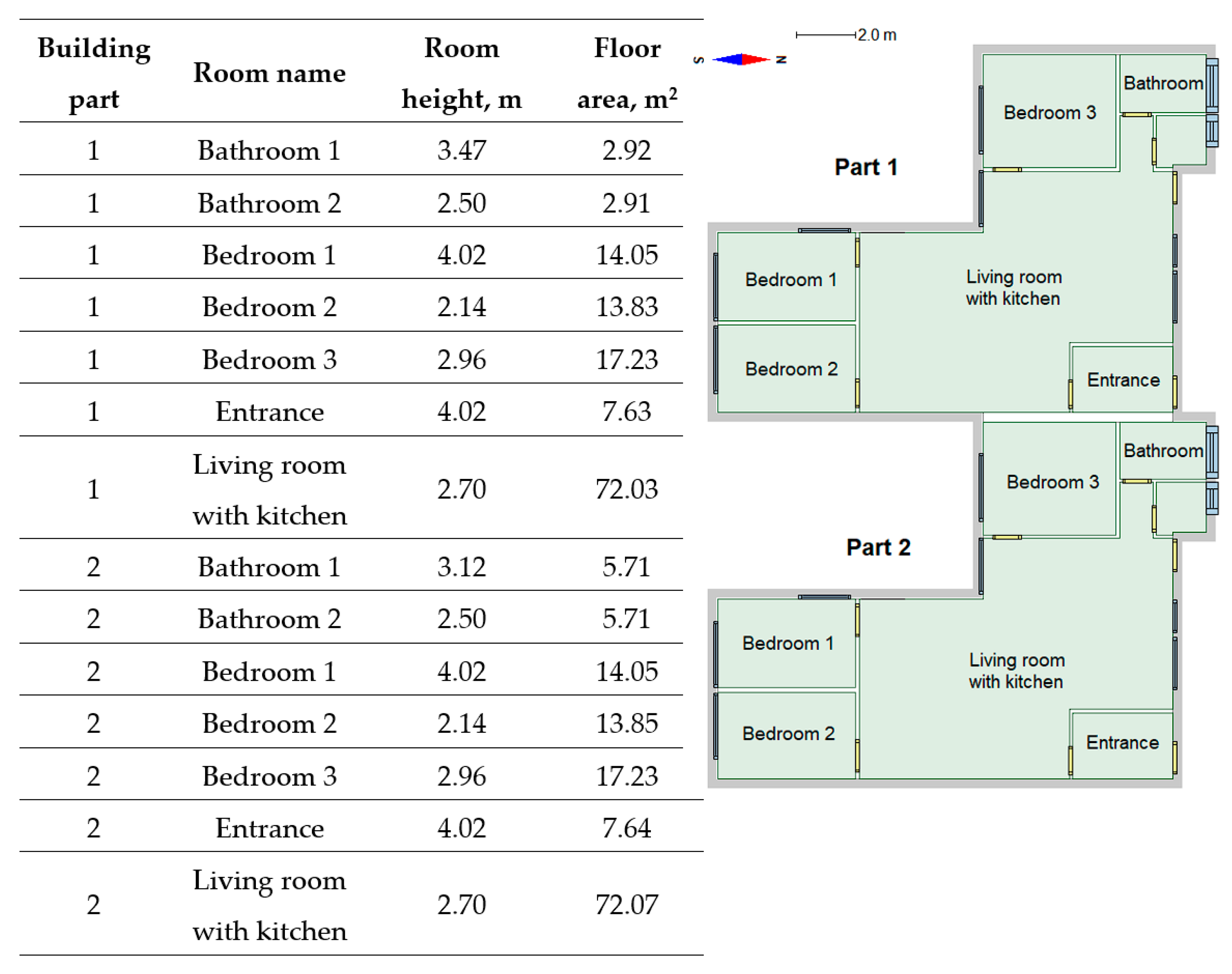

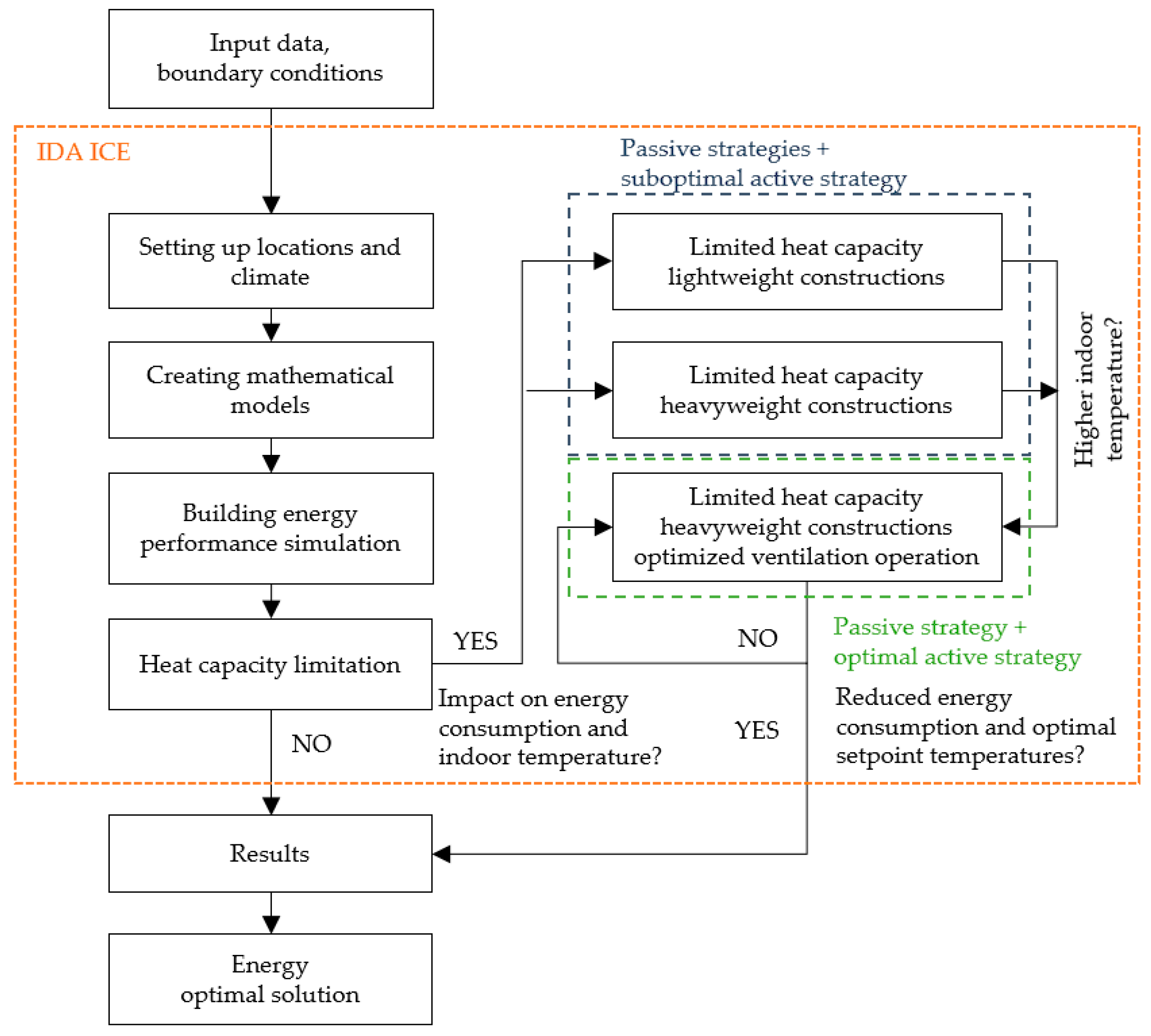
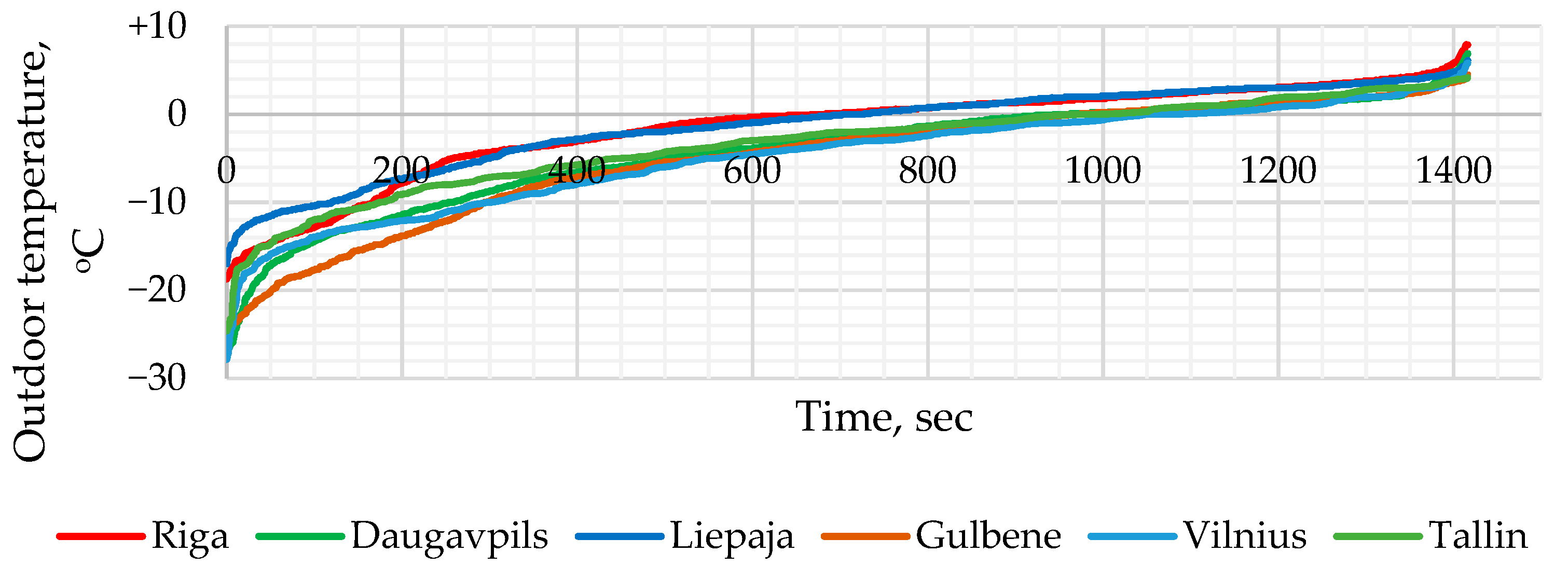


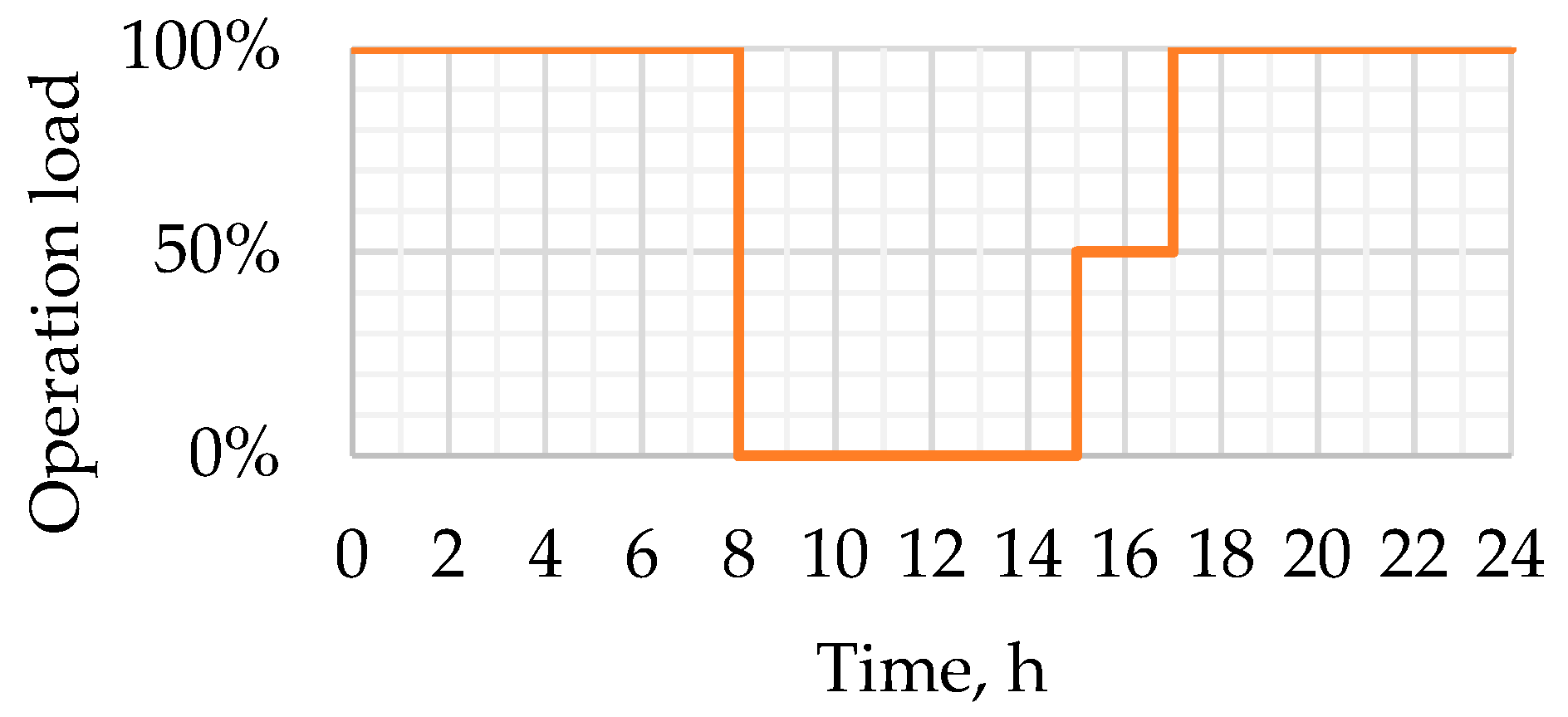
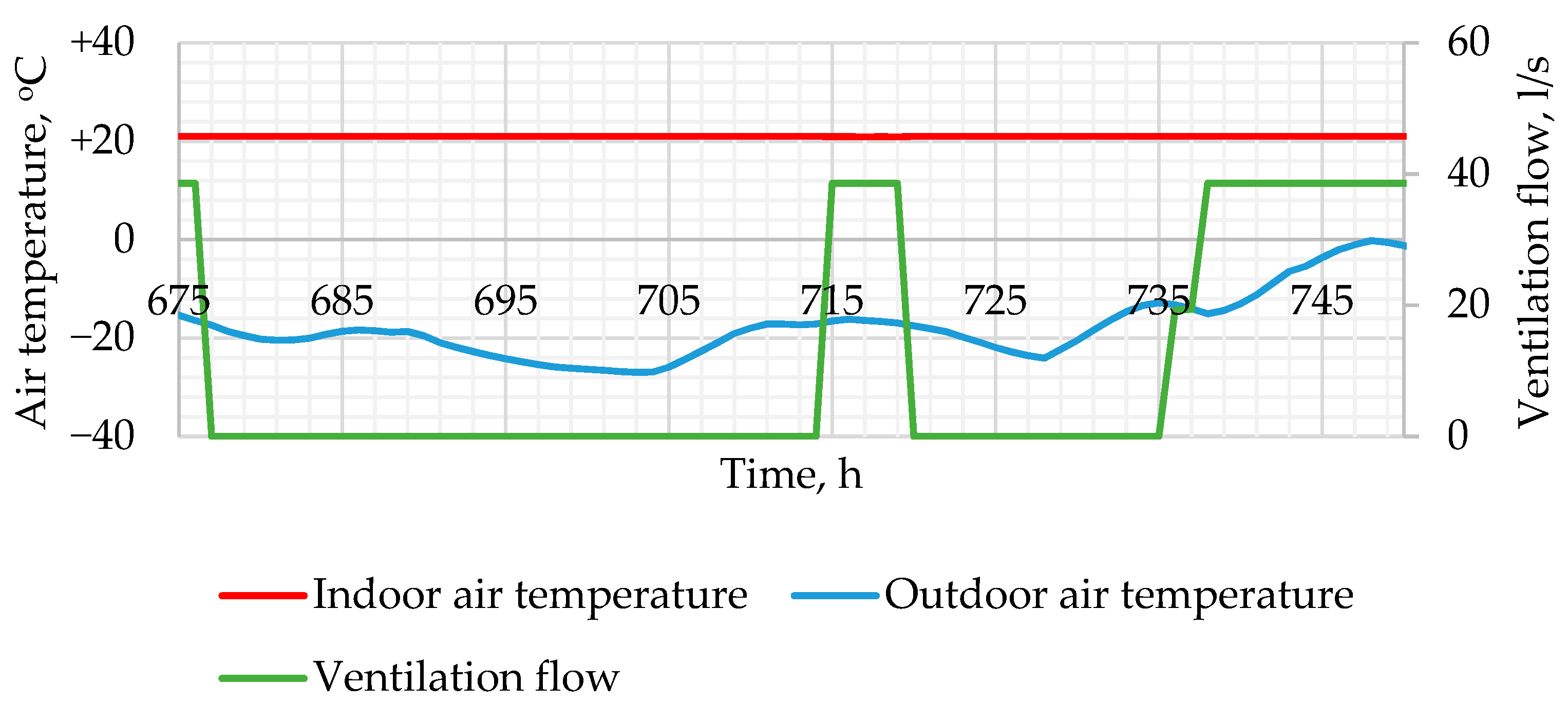
| Building Envelope | Area A/m2 | U/(W/(m2K)) | U * A/(W/K) | % of Total |
|---|---|---|---|---|
| Walls above ground | 301.72 | 0.14 | 41.84 | 16.27 |
| 110.78 | 0.16 | 17.52 | 6.82 |
| 190.93 | 0.13 | 24.32 | 9.46 |
| Roof | 275.08 | 0.09 | 24.48 | 9.53 |
| 86.24 | 0.10 | 8.76 | 3.41 |
| 188.84 | 0.08 | 15.72 | 6.12 |
| Floor towards ground | 277.58 | 0.35 | 97.21 | 37.83 |
| 277.58 | 0.35 | 97.21 | 37.83 |
| Windows | 89.15 | 0.75 | 66.86 | 26.02 |
| Doors | 10.36 | 1.67 | 17.31 | 6.74 |
| Thermal bridges | 9.25 | 3.60 | ||
| Total | 953.89 | 0.27 | 256.96 | 100.00 |
| Nr | Zone | Setpoints, °C | Occupancy, ppl. | Lighting | Equipment | Activity, met |
|---|---|---|---|---|---|---|
| 1 | Bedroom | +21/+25 | 2 | 3 W/m² | 80 W | 1.0 |
| 2 | Living room with kitchen | +21/+25 | 4 | 450 W | 1.6 | |
| 3 | Bathroom | +24/- | - | - | - | |
| 4 | Entrance | +15/- | - | - | - | - |
| Space Type | Occupancy | Lighting | Equipment |
|---|---|---|---|
| Bedroom | 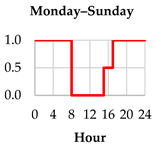 |  |  |
| Living room with kitchen | 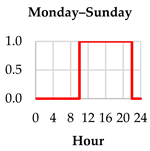 | 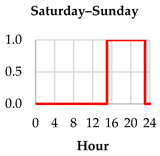 | 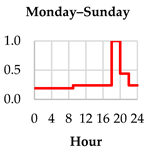 |
| Location | Design Outdoor Temperature, °C | Peak Heating Load, kW | Specific Heating Energy, kWh/m2 | Heating Energy, kWh |
|---|---|---|---|---|
| Riga | −19.6 | 12.1 | 31.7 | 7624 |
| Daugavpils | −22.3 | 15.0 | 34.7 | 8331 |
| Liepaja | −15.8 | 10.8 | 30.4 | 7292 |
| Gulbene | −21.6 | 14.4 | 36.0 | 8640 |
| Vilnius | −19.9 | 13.4 | 35.9 | 8585 |
| Tallinn | −18.9 | 13.8 | 34.7 | 8296 |
| Location | Design Outdoor Temperature, °C | Peak Heating Load, kW | Specific Heating Energy, kWh/m2 | Heating Energy, kWh | Minimum Indoor Temperature (Living Room), °C |
|---|---|---|---|---|---|
| Riga | −19.6 | 11.1 | 31.0 | 7437 | +20.7 |
| Daugavpils | −22.3 | 11.1 | 33.8 | 8118 | +16.2 |
| Liepaja | −15.8 | 10.8 | 30.4 | 7292 | +21.0 |
| Gulbene | −21.6 | 11.1 | 35.1 | 8419 | +17.0 |
| Vilnius | −19.9 | 11.1 | 34.9 | 8390 | +19.7 |
| Tallinn | −18.9 | 11.1 | 33.7 | 8094 | +19.1 |
| Location | Design Outdoor Temperature, °C | Peak Heating Load, kW | Specific Heating Energy, kWh/m2 | Heating Energy, kWh | Minimum Indoor Temperature (Living Room), °C |
|---|---|---|---|---|---|
| Riga | −19.6 | 11.1 | 31.2 | 7494 | +20.8 |
| Daugavpils | −22.3 | 11.1 | 34.1 | 8183 | +17.6 |
| Liepaja | −15.8 | 10.3 | 29.9 | 7171 | +21.0 |
| Gulbene | −21.6 | 11.1 | 35.3 | 8485 | +17.6 |
| Vilnius | −19.9 | 11.1 | 35.1 | 8441 | +20.5 |
| Tallinn | −18.9 | 11.1 | 34.0 | 8163 | +19.7 |
| Location | Design Outdoor Temperature, °C | Peak Heating Load, kW | Specific Heating Energy, kWh/m2 | Heating Energy, kWh | Minimum Indoor Temperature (Living Room), °C |
|---|---|---|---|---|---|
| Riga | −19.6 | 11.1 | 30.9 | 7418 | +21.0 |
| Daugavpils | −22.3 | 11.1 | 33.3 | 7989 | +20.9 |
| Liepaja | −15.8 | 10.4 | 29.6 | 7115 | +21.0 |
| Gulbene | −21.6 | 11.1 | 33.8 | 8114 | +20.9 |
| Vilnius | −19.9 | 11.1 | 34.4 | 8266 | +20.9 |
| Tallinn | −18.9 | 11.1 | 33.4 | 8028 | +21.0 |
Disclaimer/Publisher’s Note: The statements, opinions and data contained in all publications are solely those of the individual author(s) and contributor(s) and not of MDPI and/or the editor(s). MDPI and/or the editor(s) disclaim responsibility for any injury to people or property resulting from any ideas, methods, instructions or products referred to in the content. |
© 2023 by the authors. Licensee MDPI, Basel, Switzerland. This article is an open access article distributed under the terms and conditions of the Creative Commons Attribution (CC BY) license (https://creativecommons.org/licenses/by/4.0/).
Share and Cite
Staveckis, A.; Zemitis, J. Impact of the Limited Heat Source Capacity on Indoor Temperature and Energy Consumption in Serial nZEB Residential Buildings across the Baltic Region. Energies 2023, 16, 5924. https://doi.org/10.3390/en16165924
Staveckis A, Zemitis J. Impact of the Limited Heat Source Capacity on Indoor Temperature and Energy Consumption in Serial nZEB Residential Buildings across the Baltic Region. Energies. 2023; 16(16):5924. https://doi.org/10.3390/en16165924
Chicago/Turabian StyleStaveckis, Arturs, and Jurgis Zemitis. 2023. "Impact of the Limited Heat Source Capacity on Indoor Temperature and Energy Consumption in Serial nZEB Residential Buildings across the Baltic Region" Energies 16, no. 16: 5924. https://doi.org/10.3390/en16165924
APA StyleStaveckis, A., & Zemitis, J. (2023). Impact of the Limited Heat Source Capacity on Indoor Temperature and Energy Consumption in Serial nZEB Residential Buildings across the Baltic Region. Energies, 16(16), 5924. https://doi.org/10.3390/en16165924






